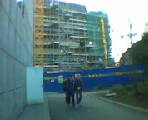|
Covered so far
The references refer to the books in the list of text books linked from the sidebar.
General Relativity
Tensors
Lecture 1: Units. Motivating metrics: measurement using infinitessimals. Examples. Isometries. (P 227-232, d'I 58ff)
Lecture 2: Isometries. Doing a general coordinate transformation.
Lecture 3: Transforming the metric tensor. An example.
Lecture 4: Tensors. (d'I 60-64).
Lecture 5: Properties of tensors. Symmetry and skew-symmetry.
Lecture 6: More tensors, discussing the derivative.
Lecture 7: The covariant derivative.
Lecture 8: Symmetrization and anti-symmetrization. Torsion.(d'I 74)
Lecture 9: The metric connections (d'I 82-85).
Geodesics, the Riemann tenson, curvature
Lecture 10: Parallel transport. The geodesic equation. (d'I 74-76)
Lecture 11: Geodesics minimize distance (d'I 74-76). The Riemann tensor (d'I 77, but note that the indices are in a different order). A formula for the Riemann tensor in terms of the connection.(d'I 86, note 1).
Lecture 12: The symmetries of the Riemann tensor. The number of independant components of the Riemann tensor. (W 142-146, MTW 326, given as an exercise, see also 334 and 343, note 2).
Lecture 13: Parallel transport around a closed loop.(W 135-136). There is another geometric interpretation of the Riemann tensor: geodesic deviation, I haven't covered this, but if you are interested it is treated in a usefully off-hand way in (W 148-149).
Lecture 14: Normal coordinates.
Lecture 15: End of normal coordinates, Bianchi identities (d'I 87), the Einstein tensor.
Speical relativity
Lecture 16: Towards special relativity. Revision of isometries, the flat plane example.
Lecture 17: Special relativity, Minkowski space, Lorentz transformations, boast, the dilation factor gamma etc.
Lecture 18: Tutorial class: problem sheet 1.
Lecture 19: End of special relativity, the energy-momentum 4-vector, the stress-energy tensor. Introduction to general relativity.
General relativity
Lecture 20: General relativity, the field equation, the cosmological constant, geodesic flow (d'I 142-143). Contrast between Einstein gravity and Newton gravity.
Lecture 21: Finding the Newton limit, Newton gravity as an approximation to Einstein gravity. (W, P2 268-272)
Lecture 22: Newton limit. Symmetry, infinitessimal symmetries.
Schwartzchild
Lecture 23: Killing's equation, static, spherical symmetric spacetime. (d'I 102-103, but note that he uses the Lie derivative, which we haven't covered. W 375ff). Matter free spherical static solutions: the Schwartzschild solution (d'I 180ff, W 179-182).
Lecture 24: Tutorial.
Lecture 25: End of Tutorial, finish deriving Schwartzschild solution.
Lecture 26: Schwatzschild solution, interpretation. (MTW part VII). Deviation of light by the sun (W 188ff, d'I 199-201).
Lecture 27: End of term, free lecture.
Lecture 28: Continuing the deviation of light by the sun.
Lecture 29: Tutorial.
Lecture 30: Tutorial.
Variational principles(d'I chapters 11 and 12)
Lecture 31: Revise the action principle, what about field theory? Motivating the Klein-Gordon equation.
Lecture 32: The Klein-Gordon equation.
Lecture 33: Integration for general spacetimes, the invariant measure. Start of the Einstein-Hilbert action. (C 121ff).
Lecture 34: More on the Einstein-Hilbert action, inclusion of matter
Lecture 35: Einstein-Hilbert, general remarks. Motivation for cosmology: the Universe is very large and scary and so on.
Lecture 36: Cancelled.
Cosmology
The Robertson-Walker models
Lecture 37: What is cosmology? Macroscopic measure, homogeneity and its consequences, the three different spatial metrics. (L 39-40).
Lecture 38: The three ansatz for homogeneous universes, the equations of cosmology: the Freidman equation and the accelleration equation.
Lecture 39: Cancelled.
Lecture 40: Physical parameters, the Hubble parameter and Hubble's law, the decelleration parameter and the density parameter. (L chapter 6).
Lecture 41: Redshift. Solving the equations for a dust universe and the different values of k. (L 31).
Lecture 42: Tutorial.
Lecture 43: More tutorial, discussion of cosmic strings.
Lecture 44: Tutorial.
Lecture 45: The dust universe, the Robertson-Walker models.
Lecture 46: Radiation, eventual dust domination. The age of the Universe.
Lecture 47: More age of the Universe, the flatness problem.
Lecture 48: Correct integration mistake in previous. Tutorial.
Lecture 49: Tutorial. More flatness problem.
None-zero cosmological constant, inflation.
Lecture 50: The relationship between seperation and red-shift. The horizon problem.
Lecture 51: Inclusion of the cosmological constant. Einstein's static universe. De Sitter space.
Lecture 52: The cosmolical constant and q_0. The cosmological constant and the age of the universe.
Lecture 53: The cosmological constant and the age of the universe, start of inflation.
Lecture 54: Inflation solving the equations, the slow roll (M chaper 9, K&T chapter 8). start of tutorial.
